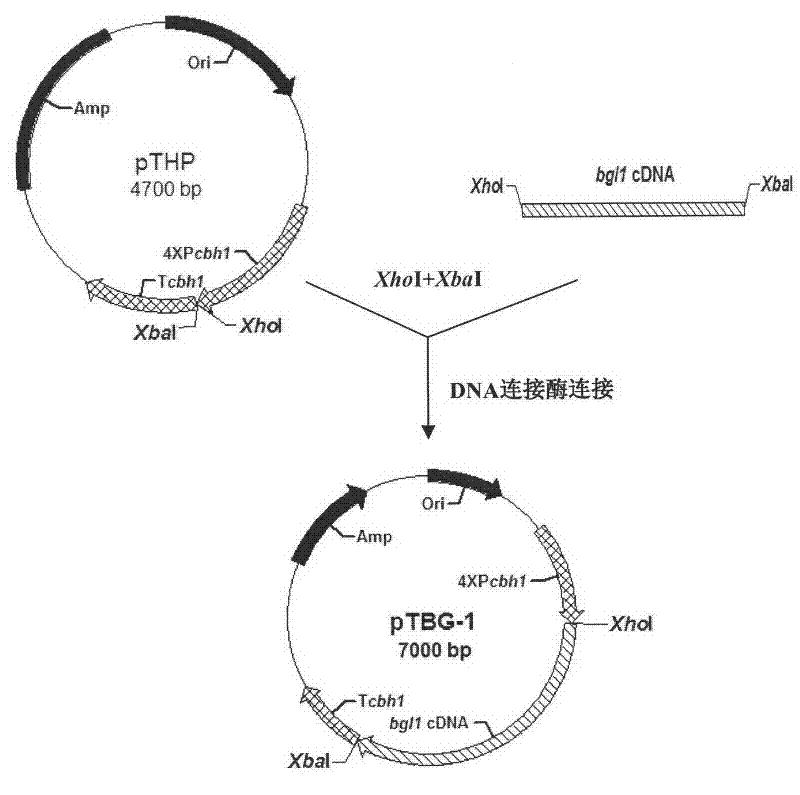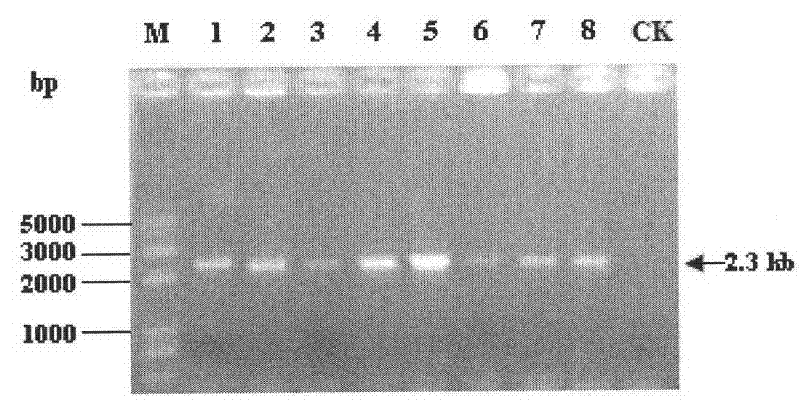Penicillium decumbens engineered strain containing over-expressed beta-glucosidase and application thereof
A technology of glucosidase and Penicillium recumbentum, which is applied in the field of microbial engineering and can solve the problem that the output of β-glucosidase cannot meet the demand and the like
- Summary
- Abstract
- Description
- Claims
- Application Information
AI Technical Summary
Problems solved by technology
Method used
Image
Examples
Embodiment 1
[0029] Example 1. β-glucosidase overexpression vector pTBG-1 transforms Penicillium decumbens JU-A10
[0030] Firstly, Double-joint PCR (DJ-PCR) technology (Jae-Hyuk Yu et al. (2004). Double-joint PCR: a PCR-based molecular tool for gene manipulations in filamentous fungi. Fungal Genetics and Biology. 41: 973- 981) Cloning of the bgl1 cDNA gene of Trichoderma reesei (GenBank sequence U09580.1). Using B1S / B1A, B2S / B2A, and B3S / B3A as primer pairs and extracted Trichoderma reesei QM9414 (ATCC 26921) chromosomal DNA as a template, amplify the 3 exon fragments of the bgl1 gene, and recover 89bp from the gel , 1760bp and 442bp amplified fragments, and then use chimeric primers to assemble the three recovered fragments. Finally, B1S and B3A were used as primers, and the self-assembled PCR product was used as a template to amplify bgl1 cDNA. The PCR product of about 2.3kb was recovered from the gel, ligated into pMD18-T, and sent to Shanghai Biological Engineering Co., Ltd. for seq...
Embodiment 2
[0058] Example 2. PCR verification of Penicillium decumbens pTBG-1 transformants
[0059] Using the extracted transformant chromosomal DNA as a template and B1S / B3A as a primer pair (see Example 1) for PCR amplification. PCR reaction system (20μl): 10×EF Taq buffer 2.0μl; dNTP mix (10mmol / L) 0.4μl; B1S and B3A (10nmol / ml) 1μl each; EF-Taq (2.5U / μl) 0.1μl; template 1μl ; make up the volume to 20 μl with sterile water. The PCR cycle program was as follows: 94°C for 5 min; 30 cycles of 94°C for 30 sec, 56.3°C for 30 sec, and 72°C for 70 sec; 72°C for 10 min.
[0060] The above PCR verification of Penicillium decumbens transformants (Gi24-2, Gi31-2, Gi53-2, Gi54-2, Gi55-1, Gi72-3, Gi78-2) found that all of them could amplify to the fragment size The bgl1 cDNA gene fragment of about 2.3kb is consistent with the size of the cDNA fragment of Trichoderma reesei bgl1, but no corresponding band appears in the starting strain, and the results are as follows figure 2 , indicating that...
Embodiment 3
[0061] Example 3. Southern blot verification of Penicillium decumbens pTBG-1 transformants
[0062] Southern blot analysis of bgl1 copy number of transformants. Using B4S / B3A as a primer pair (wherein, B3A refers to Example 1, and B4S is GAGCAACCCAGATGACCG), Trichoderma reesei chromosomal DNA is used as a template for PCR amplification, and the obtained gene fragments are purified and labeled with a gel recovery kit as probes (See DIG High Primer DNALabeling and Detection Starter Kit I, Roche's instructions for details). The PCR reaction program was: 94°C for 5min; 30 cycles of 94°C for 30s, 59°C for 30s, and 72°C for 53s; 72°C for 10min. The amplified fragment is 1688bp. Inoculate the starting strain and Gi series Penicillium decumbens transformants into 50ml basic medium respectively, culture at 200rpm 30°C for 2 days, filter the mycelia, extract a large number of chromosomes, and digest the extracted chromosomes with restriction endonuclease XhoI Overnight, 30V electroph...
PUM
 Login to View More
Login to View More Abstract
Description
Claims
Application Information
 Login to View More
Login to View More - R&D
- Intellectual Property
- Life Sciences
- Materials
- Tech Scout
- Unparalleled Data Quality
- Higher Quality Content
- 60% Fewer Hallucinations
Browse by: Latest US Patents, China's latest patents, Technical Efficacy Thesaurus, Application Domain, Technology Topic, Popular Technical Reports.
© 2025 PatSnap. All rights reserved.Legal|Privacy policy|Modern Slavery Act Transparency Statement|Sitemap|About US| Contact US: help@patsnap.com



